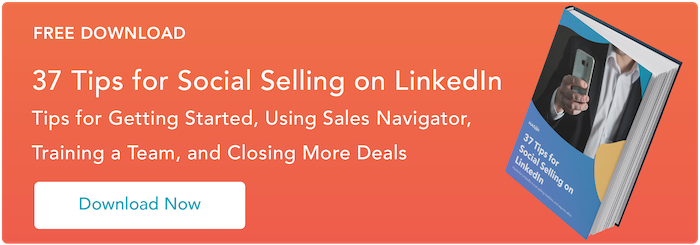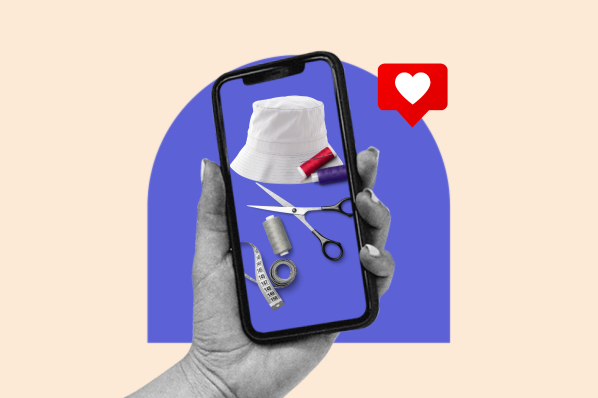With over 4.95 billion active users on social media, selling on social media is more relevant than ever. Sales leaders with a forward-thinking approach must incorporate these practices into their sales forces; otherwise, they risk falling behind more proactive competitors.
To enhance your social selling endeavors, I’ve compiled an extensive guide covering everything from the fundamentals of social selling to more advanced subjects, such as assessing its effectiveness and identifying the most beneficial social selling tools.
Whether you’re looking to initiate social selling through your sales team or independently, this comprehensive guide serves as your all-in-one resource.
Table of Contents
- What is social selling?
- The Art of Social Selling
- Social Selling Best Practices
- Optimizing Social Profiles for Social Selling
- How to Engage With Your Buyers on Social Networks
- Working Social Selling Into Your Day
- Is social selling creepy?
- Measuring Social Selling Success
- Social Selling Tools
What is social selling?
Social selling is a sales strategy that uses social media platforms to connect, engage, and build relationships with potential customers. Unlike traditional sales approaches that often involve cold calls and direct pitches, social selling focuses on leveraging social media networks to understand and interact with prospects in a more personalized and authentic way.
Today, 56% of salespeople use social media to find potential prospects. By commenting on, liking, and sharing prospects’ and customers’ posts on networks like Twitter, LinkedIn, Facebook, Instagram, and TikTok, salespeople create organic relationships with buyers over shared interests.
However, social selling isn’t for reps seeking quick wins or a silver bullet. To succeed, salespeople must put in the hours and effort to engage with their target buyers and build credibility.
The Art of Social Selling
Data shows that those who put the most effort into social selling reap the biggest rewards. For example, 76% of top-performing sales reps“always” research their prospects before reaching out.
Our State of Sales Report 2024 shows that 75% of salespeople use Facebook to find leads, followed by Instagram, Linkedin, and YouTube. The key to success here is to grow your network and build a reputation on your selected social media platforms.
But what does this look like in practice at a company? The telecommunications giant Teleus adopted social selling practices and LinkedIn’s Sales Navigator.
Teleus discovered that Sales Navigator influenced 82% of the company’s Q3 and Q4 2021 closed won revenue. These deals were 209% larger than those not influenced by Sales Navigator.

As social selling is always in flux, you should always stay up with the latest trends. By doing so, you’ll not only keep your skills sharp and know where your best prospects are at the moment but also anticipate where they might shift next.
Social Selling Best Practices
Social selling can be a lucrative resource to generate more leads and enhance your revenue.
However, there are several steps reps can take to level up their social selling skills. Here are 11 best practices to consider.

1. Optimize your social media profiles.
Optimize your social media profiles before beginning your social selling initiative. Prospects are less likely to respond if your profile is outdated or lacks essential information.
We’ll be explaining how to do it a bit later.
Quick stats: According to our internal research, 45% of salespeople find their leads on social media and 33% think that social media channels offer the highest quality leads.
2. Join LinkedIn groups and other relevant forums.
Join relevant groups and forums on LinkedIn and other sites to stay updated on industry trends.
Use valuable information to contribute to a discussion, as unsolicited, sales-y comments will annoy group members, just as a cold call or email would. Advance the conversation in a meaningful way, or just sit back and observe.
Quick stats: For 32% of the sales pros participating in our survey, LinkedIn is the most effective social media platform for researching new prospects.
Joe Zappa, founder and CEO of Sharp Pen Media, believes that you should follow and engage with influencers in your industry. By “influencers,” he refers to individuals with a sizable and engaged audience who post thought-provoking native content and comment on issues you wish to discuss.
When Zappa first joined social media, he tried to comment on posts by prospects, industry leaders, and CEOs.
“I believe this approach can undermine your social marketing strategy because most prospects and industry leaders don’t post frequently,” he says upon reflection. “On the contrary, everything they post is a link or self-promotion. This is content you can’t genuinely engage with, and there’s little hope that they will eventually notice you.”
Zappa also notes that you risk coming off as if you’re selling something — “both to the person whose post you’re commenting on and to third parties interacting with the post.”
3. Set up social listening alerts.
Use Google alerts or a social listening tool (HubSpot customers can use the Social Media Management Software) to set up social listening alerts. These are notifications that tell you when your prospects or customers experience a trigger event or post a possible sales opening.

For example, say a prospect mentions they have a problem that you can address. A social listening alert can help you quickly join the conversation with helpful content or insight.
Similarly, if a potential buyer’s company hires a new CEO or expands its business, comment on the trigger event as soon as possible to get on their radar.
4. Share content to build your credibility.
Share original, industry-specific content to build credibility and engagement on social media.
Have you read any interesting articles related to your prospects’ industry? Share them! Did you see a thought-provoking study that could be a good conversation starter? Share it!
Don’t forget to ask people to engage in the comments to start conversations.
Quick stats: 31% of sales pros think that social media content resonates most with prospects. Meanwhile, 32% are sure that social media content offers the highest ROI for B2B businesses.
5. Pay attention to the comments section.
If you see high-engagement posts in your feed, browse the comments section and join the conversation. By reading the comments your prospects are leaving, you can better understand their point of view and preferences.
You will also get an idea of what kind of content your prospects enjoy and engage with. This can help you decide what kind of content to share.
For example, someone might leave a comment on your recent product launch post asking, “Is this feature available for Light accounts?”
You might respond, “All trial accounts have access to this feature for 14 days, and Business and Pro accounts have unlimited access, too.”
While you don’t need to engage with every post you see, commenting can be a powerful tool, according to Alexander Low, Managing Director at DCM Insights.
“If you show up every day on social media here with intention and engage with people by liking or commenting on their posts, you are creating micro-moments of influence,” says Low.
If you just like/react to a post, only the author gets notified. However, when you comment on a post, every person who has liked, reacted to, commented on, or reposted gets a notification that you have commented.
“This is how you can network around lots of people at once. Focus on the outcomes you want to achieve, turn engagement into connections, and then take conversations offline; which you then have to nurture into opportunity,” says Low.
6. Share success stories.
Testimonials are a valuable form of social proof. Research shows that over 92% of B2B buyers say they are more likely to make a buying decision after reading a trustworthy review.
Sharing success stories from your other customers helps build your credibility with potential buyers. If a prospect resonates with a testimonial you share on their feed, they might be more inclined to use your solution.
Quick stats: 16% of sales professionals think that leveraging social proof is the number one strategy for selling to new customers.
“If you do a great job solving for the customer, they’ll always be keen to provide feedback — and the more you solve for them, the more positive that feedback will be. It’s a great habit to get feedback after a sales process and even better to have that feedback displayed in the form of a LinkedIn recommendation,” says Marlon De Assis-Fernandez, a senior sales manager at HubSpot.
7. Be mindful of customer support opportunities.
More buyers are interacting with businesses on social media and messaging platforms. Keep an eye on what buyers and consumers are saying about your company in these spaces — especially if a customer is dissatisfied.
Staying alert to social media chatter about your company can give your customer support team a heads-up about a problem. You’ll also be more prepared to talk to prospects who may have seen disgruntled customer content.
For example, if you see a comment on social media where a customer expresses dissatisfaction with your company’s offering, take note of the issue.
If your company’s marketing or support teams haven’t yet responded, make them aware of the comment so they can address it, and note the language they use for the resolution.
Quick stats: 22% of B2C sales pros think that using social media DMs (Direct Messaging) to provide customer support/answer questions is an effective sales strategy.
8. Be consistent.
Spending all day on social media may not be the best use of your time, but you should aim for consistent posting and engagement.
HubSpot’s own Dan Tyre recommends sales reps post at least weekly on LinkedIn with individual follow-ups for prospects who engage with your content.
“The key is to have three or four interactions within 10-12 days, which shows professional persistence without overwhelming your prospect,” Tyre says.
9. Track engagement.
Social media engagement metrics include likes, comments, shares, and high engagement. This data indicates that a piece of content truly resonates with your audience. Learn from what works best so you can continue to share the most relevant content with your audience.
For example, if you notice that content about B2B sales tools gets the most likes, comments, or shares, that’s a good indication that the topic especially resonates with your audience. You can then discuss the topic more often.
10. Subscribe to blogs.
How will you determine what to talk about with your prospects on social media? By reading similar articles and understanding potential customers’ concerns.
Check out what content your buyers are sharing, and subscribe to those blogs. Then, share the articles you think would be particularly interesting to your buyers on LinkedIn or your preferred social profile.
Quick stats: 12% of sales pros use blog posts as part of their sales enablement content, and 28% of the survey participants get their leads from blog posts.
11. Seek referrals.
Request referrals from mutual connections to gain warm introductions to specific stakeholders and potential leads.
Quick stats: 33% of sales professionals think that the highest quality leads come from referrals from existing customers.
12. Know when to move your conversations off social media.
If you want to land the sale, you’ll eventually need to take the social media connections you make offline. After making a solid connection with a prospect on social media, offer to hop on a call to continue the conversation.
This will allow you to learn more about the prospect’s pain points or situation, which can help you gain the clarity you need to land the sale.
Tyre says that if interactions with a prospect that fits his vertical market and ideal customer profile move in a positive direction, he’ll seek out the contact’s email address to set up a call. They can then continue the conversation off social media.
13. Optional tip: Subscribe to LinkedIn Sales Navigator.

LinkedIn Sales Navigator is a premium service priced at $99.99 per month, with a discount for annual subscriptions. The tool helps sales reps identify new leads based on their location, industry, company size, and other attributes you need to build a prospect list.
Want more? Watch this webinar as social selling experts Olga Bondareva, Ekaterina Altbregina, Sofia Lopatkina, and Assylkhan Shaidollayev share their best practices and successful case studies:
You can also listen to Guillaume Moubeche’s strategy for turning LinkedIn into a heavy lead machine:
14. Optional tip: Blog.
Sales reps don’t have to blog for effective social selling, but it can be a valuable way to attract qualified prospects. You can build influence in your industry and provide value to your audience with original insight and thought leadership.
Blogging can pay dividends for your lead-generation efforts. Businesses that blog at least 16 times a month see 350% more traffic than those that don’t.
To craft a post that captures your prospects’ attention, consider the following tips:
- Select a topic that resonates with your audience’s interests.
- Create compelling titles to grab attention.
- Avoid making your post excessively sales-oriented.
- Infuse your perspective and insights into the content.
- Share your posts across your social profiles, including Twitter and LinkedIn, and employ relevant hashtags to enhance discoverability.
Optimizing Social Profiles for Social Selling
In the world of social selling, your social media account needs to be more than a digital resume. Your profiles should actively help you cultivate a reputation with your buyers as a trusted advisor who brings fresh insights to their business.
Your profiles need to reflect this new purpose. See ways you can optimize your social presence below.
Twitter profiles don’t have much real estate, so it’s easy to give yours a makeover. Follow these steps to do so:
- Use a professional picture for your profile photo.
- Use a positioning statement in your bio that includes a mini-insight.
- Link to your company’s Twitter account (Example: Sales Rep @company).
- List your LinkedIn profile.
- Include relevant hashtags that your buyers follow.
If sellers contact them, 42% of buyers in the U.S. and Canada research those sellers by looking at their LinkedIn profiles. That being said, optimizing your LinkedIn profile is an extremely valuable exercise.
Here are seven tips to ensure your LinkedIn profile is optimized for social selling:
- Have a current, hi-res picture.
- Don’t just use your job title. Craft a compelling headline that goes beyond your job title. For example, consider answering two questions in your headline: Who do you help, and how do you help them?
- Write a 3X3 summary — three paragraphs with three or fewer sentences each. Reiterate your value proposition in the first, provide some social proof of how you help clients achieve results in the second, and conclude with a brief call-to-action explaining why and how a buyer should connect with you.
- Post visual content that adds value to your potential buyers.
- In the experience section, emphasize how you enabled customers to improve their business — not how many times or by how much you exceeded quota.
- Seek recommendations from satisfied customers to bolster your credibility.
- Join groups relevant to your buyers.
To view a visual template illustrating what an optimized LinkedIn profile for social selling looks like, click on the image below.

How to Engage With Your Buyers on Social Networks
Social selling is all about engagement. But bear in mind that your interactions should be thoughtful, relevant, and personalized.
Social engagement comes in four primary forms: sharing, liking, commenting, and connecting.
Sharing
Share content that interests your target buyers. The more relevant, exciting content you can share, the better.
You can link to your company’s content and what Jill Rowley calls “OPC” — other people’s content. Switching up your sources will nix the perception that you’re self-serving.
Jill Konrath, keynote speaker and sales expert, shares helpful content with her target audience on both her LinkedIn and Twitter pages daily. Konrath uses her expert knowledge to share tangible advice and draw in a captive audience.
Sharing content is vital as more consumers make buying decisions online. In fact, 30% of buyers report reading more than five pieces of content before making a purchase.
Liking
When you don’t have time for a comment or don’t have anything substantial to add, a like or favorite works just as well. Likes also work as a thank you when others share or retweet your content.
Commenting
A comment should not just be a sales pitch or a link to your company’s website. Instead, it should be a thoughtful and thought-provoking response to an article. By commenting on lively, active threads that hit the core interests of your target audience, you can drive engagement for your own site.
For example, Lisa Dennis, president and founder at Knowledgence Associates, shares posts that her target buyers would care about and adds thoughtful comments to others’ content.
Want to make the most of your comments? Check out this guide on the best times to post across different social media networks.
Connecting
On Twitter, you can follow prospects to your heart’s desire. But on LinkedIn, you should be more judicious.
A good rule of thumb for LinkedIn is not to request to connect with someone until you’ve had a meaningful interaction, either in person or online. Then, you can send a personalized invitation explaining why you’d like to be in their network.
For example, to request to connect, you can reference a blog post the person wrote or a piece of content they recently shared to show that you did your research.
Here’s an example of a strong LinkedIn invitation:
“Hi Jaime, we share 25 connections here, including Michelle Lee, who introduced me to Amy Chang, which landed me my current advisor position. Several people have mentioned you as someone I need to meet. I would love to connect.”
Working Social Selling into Your Day
One of the most significant perceived hurdles to adopting social selling is that it takes too much time to make sales. How can sales reps keep up with their buyers on LinkedIn and Twitter when they’re also trying to, you know, sell?
Like anything else, developing a routine around social selling will cut down on the time commitment.
Ben Martin, Director at Automation Squared Ltd, recommends the following 12-step social selling process that can take as little as 30 minutes per day.
- Find relevant content to share.
- Share the relevant content on social networks.
- Check on who’s viewed your LinkedIn profile.
- Interact with target buyers who look at your profile and send connection requests when appropriate.
- Monitor engagement with your content.
- Interact with those who engage with your content.
- Review LinkedIn alerts.
- Organize target buyers in a LinkedIn folder.
- Share content with target buyers.
- Review any additional trigger event alerts.
- Respond to messages.
- Initiate new conversations.
Is social selling creepy?
Many reps are hesitant to adopt social selling because they fear it will come off as “creepy” to buyers. After all, nobody likes the feeling that they’re being researched by people they don’t know.
Salespeople sometimes worry that starting a cold email with “I noticed on LinkedIn that you…” or “I liked your tweet about…” might scare prospects away instead of drawing them in.
If you’re worried about turning off prospects when social selling, here are some best practices for interacting on social media in a way that doesn’t feel creepy:
- Ideally, focus on interacting with prospects who have demonstrated interest in your products or services by engaging with your content, such as commenting on or sharing your posts. Messaging prospects who haven't shown interest can be perceived as intrusive.
- Personalize your messages. In general, tailored messages are seen as less intrusive compared to generic ones.
- Don’t reach out to contacts on non-professional accounts, such as personal Instagram or Facebook pages. For sales representatives, LinkedIn provides a more suitable platform for professional and positive engagement with prospects.
- Engage in “light” social selling interactions. Actions such as liking, favoriting, or retweeting are generally considered less invasive than more in-depth interactions, such as direct messaging or commenting.
Remember, you want social media interactions to feel natural and conversational for both you and the prospect.
Measuring Social Selling Success
Measurement is arguably the most challenging part of a social selling initiative because the effects aren’t linear. There’s no formula yet that correlates the number of content shares or likes with the number of deals closed. But this doesn’t mean that you can’t measure social selling at all.

The majority of the social selling metrics available today assess an individual’s aptitude, like with Buzzsumo. LinkedIn has created its own tool, the Social Selling Index, to help those with Sales Navigator Premium accounts understand their effectiveness on the platform.
Social Selling Index
The Social Selling Index (SSI) measures how effective you are at establishing your professional brand and presence on LinkedIn.
To access it, you must have a subscription to LinkedIn’s Sales Navigator Premium, where you’ll gain entry to a daily updated Social Selling Dashboard (as shown below).
The Dashboard gives insights into your effectiveness in establishing your personal brand, reaching the right people, engaging with insights, and building relationships. Your effectiveness is scored out of 100.

High-performing salespeople are 12% more likely to use social media to sell, and social sellers using the index outsell peers who don’t use social media.
On a larger scale, a company can also add a “social” source of deal options to their CRM software to see how many customers are coming from social selling.
Sales leaders who’d like to conduct a study on how social selling translates into sales should first systematize the practice and train reps on social best practices. They can then measure what impact the new routine has on closed deals by comparing future results to historical numbers.
Social Selling Tools
Social selling is easier to implement when you have the right tools for the job.
The product you choose depends on the specific needs of your organization and the challenges your buyers face.
Some of the most popular social selling tools available today include the following.
Oktopost

Oktopost is a powerful software suite that allows marketers to build B2B social selling plans for their organization. The platform also includes robust data collection and analysis capabilities, allowing sales teams to track ROI and derive insights from customer engagement.
Oktopost also integrates with several of the largest CRMs, making it easy to deploy in your organization.
Price: Pricing is available upon request.
Pulsar Platform

Pulsar Platform is an audience intelligence and social listening platform. This tool identifies trends and insights from the vast social media space.
Pulsar can help sales teams shape their messaging with real-time data on social media trends and conversations. You can also identify influencers big and small in social spaces, helping you maximize your sales efforts.
Price: Pricing is available upon request.
Vidyard
.webp)
Vidyard lets you upload and share custom videos, which can give your sales team a critical edge in social selling. Video can smooth away countless friction points, reducing the number of steps it takes to bring prospects through your sales pipeline.
Vidyard is easy to use and includes numerous video templates that can help your team easily create professional-looking videos on demand.
Price: A free version is available. Pro costs $19 a month annually or $29 monthly. The Plus plan costs $89 per person a month and starts at $708 annually. The Business plan’s pricing is available upon request.
Seismic

Social selling involves countless moving parts, and Seismic helps you coordinate them all. With Seismic, you can track what pieces of content you share in each channel and their metrics to analyze performance.
Seismic allows social sellers to optimize their content delivery across the buyer’s journey, helping them to close more sales.
Price: Pricing is available upon request.
Getting Started With Social Selling
Now that you’re equipped with the basics of social selling, how to measure its effectiveness, and some social selling tools, you’re ready to get started with social sales.
Be sure to incorporate the best practices into your daily routine and train your sales team to do the same.
Editor's Note: This post was originally published in November 2014 and has been updated for accuracy and comprehensiveness.













